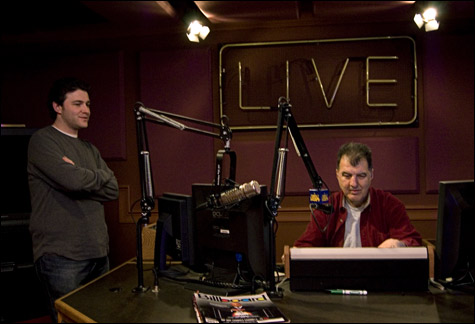
WE GOT IT ALL ON UHF: The documentary by Eric Green (left, with V66’s John Garabedian) recalls the pre-Internet days of Boston’s music-video channel. |
In February of 1985, I was almost nine, and I was sick of my single digits. Sure, I'd sneak an episode of Muppet Babies on the weekends, but I was gunning to grow up. Meanwhile, somewhere in London, Mark Knopfler was tidying up his final mix of "Money for Nothing" — and though its soon-to-be-ubiquitous mantra of desire hadn't touched my ears yet, it was already alive in my gut, ready for its reflection in the zeitgeist: I wanted my MTV.
My folks didn't care. "Why would we pay for TV when we can get it for free?" It was common riposte in households across Massachusetts, where cable had only recently reared its coaxial head. Forty miles east of Fitchburg, in Bedford, a young Eric Green was in the same boat. For one who had gorged on MTV, HBO, and Nick at his dad's place, the buffet of UHF offerings at home seemed stingy. That is, until V66 switched on.
"They'd play a rap video, then a dance video, then a heavy-metal video," Green recalls. "I was just learning about music and forming my own opinions, so it was terrific to have a free channel running different music all day."
Tenderly known among friends as "the poor man's MTV," V66 was a godsend to many a hungry young ear. When local broadcasting hero John Garabedian's friendly mug suddenly appeared amid a flurry of static and a roomful of tiny monitors and other fancy-looking tech-junk, it felt as if someone had broken into the television to create a single sliver that wasn't just a tolerable alternative to WLVI's Creature Double Feature repeats but an actual outpost of cool.
Or at least, it was untamed in a way that was cool by default. Locals (like the Del Fuegos and 'Til Tuesday), international flash phenoms (like Double and Paul Hardcastle), and superstars (uh, Culture Club and A-ha?) enjoyed the same legitimacy on the level playing field of the burgeoning new music-video platform. And since "Sledgehammer" hadn't made "Money for Nothing" its visual bitch yet, the technical demands for a winning video were delightfully, accessibly low. (See: "Out of Touch" by Boston's own Lizzie Borden and the Axes.) Plus, it was all live — and in the days before the five-second delay, this was an exciting prospect.
Green's fond memories of the V never left him. And the more he recalled about the station, the more his interest broadened from mere nostalgia into a driving fascination with the unique 18-month cultural moment that the channel represented — a brief pre-Internet stretch when TV was being used for good, as mortar for a community that couldn't otherwise form.
Over the past two years, he's been channeling his energy into a feature-length documentary about the station titled Life on the V. And next Thursday, he'll help raise funds for post-production while celebrating the 25th anniversary of the station with a royal reunion bash at the House of Blues featuring iconic V66 VJs (perchance to see dreamy David O'Leary? or the avuncular Arnie "Woo Woo" Ginsburg?), plus performances from early V66 all-stars like O Positive, Rods and Cones, the Fools, Animotion, and a custom-reunited Lizzie Borden and the Axes.